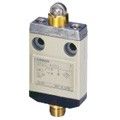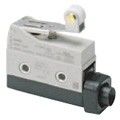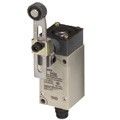What is a Limit Switch?
Definition

A Limit Switch is a detection switch which consists of a basic switch in a metal or resin case.
The strong outer case protects the inside of the switch from external forces, moisture, oil, dust and dirt so that it can be used in locations that demand mechanical strength and environmental resistance.
Features
| High Mechanical Durability | These switches will encounter significant amounts of force and shock, so the case and actuator are constructed from tough materials. |
|---|---|
| Superior Environmental Resistance | We developed a sealed design and materials that can be used even in harsh environments with exposure to moisture, oil, dust, dirt and high or low temperatures. |
Limit Switches are used in environments that demand mechanical strength or environmental resistance where normal Basic Switches could not be used.
Models
There are two types of Limit Switches: General-purpose Vertical Types and Horizontal Types, which have superior mechanical strength.
We have a rich lineup of products in a wide variety of sizes so that you can choose the most suitable switches for your application environment.
We even offer switches that provide improvement of particular specification, such as high sealing property or high durability for use in harsh conditions.

| Vertical Types | |||
|---|---|---|---|
 High sealing property, High shock resistance and High strength |  Standard Switches with many variations |  Compact and Low-cost | 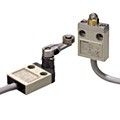 Compact and Low-profile with a high sealing property |
| Horizontal Types | ||||
|---|---|---|---|---|
 High-shut-off capacity and High durability |  High durability at a low price |  Compact with high accuracy |  Compact with high durability |  Light and compact, High durability, High sealing property |
Select the best configuration for your applications from a wide variety of external sizes and specifications.
Structures
The main components that make up a Limit Switch are the actuator, cover, bult-in switch and switch case.

1.Actuator
The force and movement received from the detection object are relayed to the built-in switch through the internal plunger.
The major types of actuators are roller lever, plunger and flexible rod.

 Roller Lever |  Plunger |  Flexible Rod |
Select the best actuator type based on the shape and movement of the detection object.
2.Cover
Attach the cover after you have wired the external connection cable to the terminal on the built-in switch.
Use rubber packing to seal the connection between the cover and the switch case.
3.Built-in Switch
The built-in switch can instantly turn ON and OFF through its snap-action mechanism.
The external movement or force reverses the movable spring and moves the moving contact from the lower NC contact to the upper NO contact.

4.Switch Case
The case encloses the built-in switch for protection.
Cases are made of metal or resin to increase mechanical strength.
A special connector is attached to the conduit opening on the bottom of the switch case to secure the external connection cable into place and to form a protective seal for the internal components.
Lineup
Omron offers a wide array of different types of switches for different applications. Check out our product lineup for switches below.
Applications
Position Detection for Production Lines
- Position detection for drive units (such as ones for assembly robots) and workpieces
Position Detection for Industrial Equipment and Devices
- Open or closed detection for doors and covers on machine tools or semi-conductor manufacturing equipment

Assembly Robots

Machine Tools
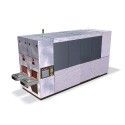
Semiconductor Manufacturing Equipment


